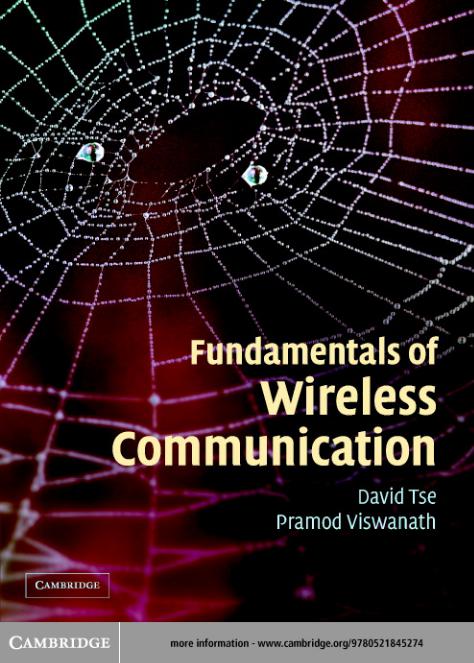
Fundamentals Of Wireless Communication
.pdf
TEAM LinG

Fundamentals of Wireless Communication
The past decade has seen many advances in physical-layer wireless communication theory and their implementation in wireless systems. This textbook takes a unified view of the fundamentals of wireless communication and explains the web of concepts underpinning these advances at a level accessible to an audience with a basic background in probability and digital communication. Topics covered include MIMO (multiple input multiple output) communication, space-time coding, opportunistic communication, OFDM and CDMA. The concepts are illustrated using many examples from wireless systems such as GSM, IS-95 (CDMA), IS-856 (1× EV-DO), Flash OFDM and ArrayComm SDMA systems. Particular emphasis is placed on the interplay between concepts and their implementation in systems. An abundant supply of exercises and figures reinforce the material in the text. This book is intended for use on graduate courses in electrical and computer engineering and will also be of great interest to practicing engineers.
David Tse is a professor at the Department of Electrical Engineering and Computer Sciences, University of California at Berkeley.
Pramod Viswanath is an assistant professor at the Department of Electrical and Computer Engineering, University of Illinois at Urbana-Champaign.

Fundamentals of
Wireless Communication
David Tse
University of California, Berkeley
and
Pramod Viswanath
University of Illinois, Urbana-Champaign
Cambridge, New York, Melbourne, Madrid, Cape Town, Singapore, São Paulo
Cambridge University Press
The Edinburgh Building, Cambridge , UK
Published in the United States of America by Cambridge University Press, New York
www.cambridge.org
Information on this title: www.cambridge.org/9780521845274
© Cambridge University Press 2005
This publication is in copyright. Subject to statutory exception and to the provision of relevant collective licensing agreements, no reproduction of any part may take place without the written permission of Cambridge University Press.
First published in print format 2005
- |
- - - - |
eBook (NetLibrary) |
|
- |
- - - |
eBook (NetLibrary) |
|
- |
- - - - |
hardback |
|
- |
- - - |
hardback |
|
Cambridge University Press has no responsibility for the persistence or accuracy of s for external or third-party internet websites referred to in this publication, and does not guarantee that any content on such websites is, or will remain, accurate or appropriate.
To my family and Lavinia
DT
To my parents and to Suma
PV

Contents
|
Preface |
page xv |
|
Acknowledgements |
xviii |
|
List of notation |
xx |
1 |
Introduction |
1 |
1.1 |
Book objective |
1 |
1.2 |
Wireless systems |
2 |
1.3 |
Book outline |
5 |
2 |
The wireless channel |
10 |
2.1 |
Physical modeling for wireless channels |
10 |
2.1.1 |
Free space, fixed transmit and receive antennas |
12 |
2.1.2 |
Free space, moving antenna |
13 |
2.1.3 |
Reflecting wall, fixed antenna |
14 |
2.1.4 |
Reflecting wall, moving antenna |
16 |
2.1.5 |
Reflection from a ground plane |
17 |
2.1.6 |
Power decay with distance and shadowing |
18 |
2.1.7 |
Moving antenna, multiple reflectors |
19 |
2.2 |
Input /output model of the wireless channel |
20 |
2.2.1 |
The wireless channel as a linear time-varying system |
20 |
2.2.2 |
Baseband equivalent model |
22 |
2.2.3 |
A discrete-time baseband model |
25 |
|
Discussion 2.1 Degrees of freedom |
28 |
2.2.4 |
Additive white noise |
29 |
2.3 |
Time and frequency coherence |
30 |
2.3.1 |
Doppler spread and coherence time |
30 |
2.3.2 |
Delay spread and coherence bandwidth |
31 |
2.4 |
Statistical channel models |
34 |
2.4.1 |
Modeling philosophy |
34 |
2.4.2 |
Rayleigh and Rician fading |
36 |
vii
viii Contents
2.4.3 |
Tap gain auto-correlation function |
37 |
|
Example 2.2 Clarke’s model |
38 |
|
Chapter 2 The main plot |
40 |
2.5 |
Bibliographical notes |
42 |
2.6 |
Exercises |
42 |
3 |
Point-to-point communication: detection, diversity |
|
|
and channel uncertainity |
49 |
3.1 |
Detection in a Rayleigh fading channel |
50 |
3.1.1 |
Non-coherent detection |
50 |
3.1.2 |
Coherent detection |
52 |
3.1.3 |
From BPSK to QPSK: exploiting the degrees |
|
|
of freedom |
56 |
3.1.4 |
Diversity |
59 |
3.2 |
Time diversity |
60 |
3.2.1 |
Repetition coding |
60 |
3.2.2 |
Beyond repetition coding |
64 |
|
Summary 3.1 Time diversity code design criterion |
68 |
|
Example 3.1 Time diversity in GSM |
69 |
3.3 |
Antenna diversity |
71 |
3.3.1 |
Receive diversity |
71 |
3.3.2 |
Transmit diversity: space-time codes |
73 |
3.3.3 |
MIMO: a 2 × 2 example |
77 |
|
Summary 3.2 2 × 2 MIMO schemes |
82 |
3.4 |
Frequency diversity |
83 |
3.4.1 |
Basic concept |
83 |
3.4.2 |
Single-carrier with ISI equalization |
84 |
3.4.3 |
Direct-sequence spread-spectrum |
91 |
3.4.4 |
Orthogonal frequency division multiplexing |
95 |
|
Summary 3.3 Communication over frequency-selective channels |
101 |
3.5 |
Impact of channel uncertainty |
102 |
3.5.1 |
Non-coherent detection for DS spread-spectrum |
103 |
3.5.2 |
Channel estimation |
105 |
3.5.3 |
Other diversity scenarios |
107 |
|
Chapter 3 The main plot |
109 |
3.6 |
Bibliographical notes |
110 |
3.7 |
Exercises |
111 |
4 Cellular systems: multiple access and interference management |
120 |
|
4.1 |
Introduction |
120 |
4.2 |
Narrowband cellular systems |
123 |
4.2.1 |
Narrowband allocations: GSM system |
124 |
4.2.2 |
Impact on network and system design |
126 |
ix Contents
4.2.3 |
Impact on frequency reuse |
127 |
|
Summary 4.1 Narrowband systems |
128 |
4.3 |
Wideband systems: CDMA |
128 |
4.3.1 |
CDMA uplink |
131 |
4.3.2 |
CDMA downlink |
145 |
4.3.3 |
System issues |
147 |
|
Summary 4.2 CDMA |
147 |
4.4 |
Wideband systems: OFDM |
148 |
4.4.1 |
Allocation design principles |
148 |
4.4.2 |
Hopping pattern |
150 |
4.4.3 |
Signal characteristics and receiver design |
152 |
4.4.4 |
Sectorization |
153 |
|
Example 4.1 Flash-OFDM |
153 |
|
Chapter 4 The main plot |
154 |
4.5 |
Bibliographical notes |
155 |
4.6 |
Exercises |
155 |
5 Capacity of wireless channels |
166 |
|
5.1 |
AWGN channel capacity |
167 |
5.1.1 |
Repetition coding |
167 |
5.1.2 |
Packing spheres |
168 |
|
Discussion 5.1 Capacity-achieving AWGN |
|
|
channel codes |
170 |
|
Summary 5.1 Reliable rate of communication |
|
|
and capacity |
171 |
5.2 |
Resources of the AWGN channel |
172 |
5.2.1 |
Continuous-time AWGN channel |
172 |
5.2.2 |
Power and bandwidth |
173 |
|
Example 5.2 Bandwidth reuse in cellular systems |
175 |
5.3 |
Linear time-invariant Gaussian channels |
179 |
5.3.1 |
Single input multiple output (SIMO) channel |
179 |
5.3.2 |
Multiple input single output (MISO) channel |
179 |
5.3.3 |
Frequency-selective channel |
181 |
5.4 |
Capacity of fading channels |
186 |
5.4.1 |
Slow fading channel |
187 |
5.4.2 |
Receive diversity |
189 |
5.4.3 |
Transmit diversity |
191 |
|
Summary 5.2 Transmit and recieve diversity |
195 |
5.4.4 |
Time and frequency diversity |
195 |
|
Summary 5.3 Outage for parallel channels |
199 |
5.4.5 |
Fast fading channel |
199 |
5.4.6 |
Transmitter side information |
203 |
|
Example 5.3 Rate adaptation in IS-856 |
209 |
5.4.7 |
Frequency-selective fading channels |
213 |
